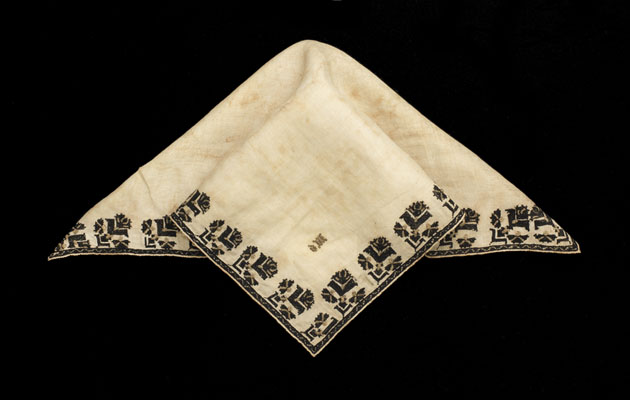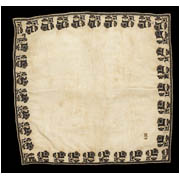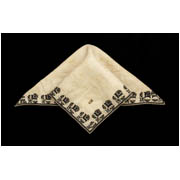Details
- Object type
handkerchief
- Place Associated
England (place of manufacture)
- Date
circa 1600-1625
- Materials
linen, silk, silver-gilt
- Dimensions
overall: 380 mm x 370 mm
- Description
-
Man’s or woman’s handkerchief in plain weave linen embroidered in black silk and silver-gilt threads worked in cross, chain, plaited braid, satin and woven wheel stitch in a stylized border design around the edge. Outer border of voided chevron pattern worked in cross stitch with silver-gilt thread going through the voided line worked in running stitch. Inner border of repeated stylised flower motifs (seven along the top, eight and half down the right side, seven and a half along the bottom and nine and half along the left side) worked in cross stitch with details in silver-gilt thread worked in chain, plaited braid, satin and woven wheel stitch. Top right corner marked with initials ‘MQ’ (?) in silver-gilt threads worked in cross and satin stitch. Narrow hem around edge with linen turned under and stitched down with a cream thread. The cross stitch worked by eye, rather than counted.
This handkerchief is embroidered with a monochromatic design in black silk thread is known as blackwork. Blackwork is a style of embroidery stitched with a monochromatic design worked predominately in black silk thread. Many, but not all, designs were worked with counted stitches and the monochromatic designs were also worked in red, blue or other colours. Blackwork is thought to have originated in North Africa with early surviving examples from Egypt dating to the Mamluk period (1250–1517), including textile fragments in the Yousef Jameel Centre for Islamic and Asian Art, Ashmolean Museum, Oxford (for example EA1993.152). The Umayyad Caliphate introduced the style to Spain where by the late 1400s it had spread from Mudéjar art into court dress. One of the earliest formal portraits depicting its use is Juan de Flandes, Isabel of Castille, circa 1500–04 (Palacio Real, Madrid). Isabel's daughter, Catherine of Aragon (1485–1536), is said to have introduced the style to England when she married Arthur Tudor (1486–1502), Prince of Wales, son of Henry VII (1457–1509), in 1501. Often referred to in England as Spanish work at this date, it can be seen decorating shifts in several early Tudor court portraits by Hans Holbein the Younger (circa 1497–1543) and his peers. By the late 1600s it was also being used to decorate accessories, main garments and domestic textiles.
The flowers are probably carnations, also known as gilly flowers. The flower is thought to have originated from around the Mediterranean. Their scientific name, Dianthus caryophyllus, derives from the Greek for ‘heavenly flower’. They are associated with the Virgin Mary’s grief and symbolise a mother’s love. Carnations were a popular motif during the 1500s and early 1600s. A design for carnations was included in Jacques le Moyne, La Clef des Champs, 1586 and William Lawson, The Country Housewife’s Garden, 1631, states that they are ‘of all the flowers (save the damask rose) the most pleasant in sight and smell’.
Provenance: John Hunt (1900–76); from whom purchased by Sir William Burrell on 1 September 1939 for £22.
- Credit Line/Donor
Gifted by Sir William and Lady Burrell to the City of Glasgow, 1944
- Collection
Burrell Collection: British Embroideries
- ID Number
29.148
- Location
In storage



